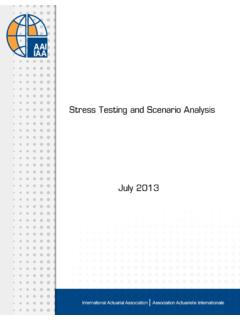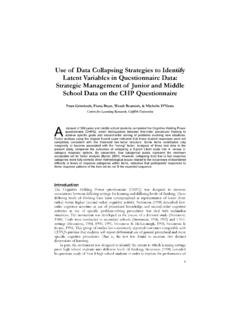Transcription of Contents page - grimbeek.com.au
1 reporting MANOVA: Four examples (not necessarily definitive) Contents page Contents i MANOVA 1 Example 1: Gender in the 1 Example 2: NESB teaching 1 Examining associations between scale scores and demographic 1 Example 3: 3 Example 4: 4 Method of 4 Multivariate 4 Univariate Effects Background 6 i reporting MANOVA: Four examples (not necessarily definitive) MANOVA reporting Example 1: Gender in the future An initial MANOVA examined age and educational literacy as covariates, the three latent variables as dependent variables (DVs), and gender of baby in survey and gender of participant as independent variables (IVs). After excluding age and educational level as nonsignificant, a follow-up MANOVA examined associations between the DVs and IVs described above.
2 It showed a significant multivariate effect for the three latent variables as a group in relation to the gender of the baby in the survey (girl versus boy: p<.001) and the gender of the participant completing the survey (p<.01). However, the interaction between gender of participant and gender of baby in survey was nonsignificant. Univariate analyses for the effect of the baby in the survey significant predicted responses related to consumer trends (p<.05), with responses significantly more positive for girl than boy babies. Follow-up nonparametric tests for items related to consumer trends indicated that male and female participants as a group were likely to indicate that baby girls in the future were not only more likely to follow fashion trends (p<.)
3 01) but also to keep up with technology (p<.01). Univariate analyses for gender of participant significantly predicted responses related to consumer trends such that males responded more positively than females and for emerging lifestyle such that females responded more positively than males. Follow-up nonparametric tests for items related to consumer trends indicated that despite the significant univariate effect, the gender of participant did not influence responses to these items significantly. Follow-up nonparametric tests for items related to emerging lifestyle indicated that females were more likely to respond that babies of either gender would in future be able to live anywhere (p<.
4 05). Example 2: NESB teaching practice Examining associations between scale scores and demographic variables A series of multivariate ANOVAs were conducted with six demographic variables as independent variables, and with intercultural understanding and teaching confidence as dependent variables. The six independent variables included: years of teaching experience, teaching sector, training opportunities, linguistic status, cultural groups taught, and percentage of NESB students in classrooms. Significant associations were examined further by non-parametric testing (Kruskal-Wallis). Findings revealed nonsignificant associations between the scale scores for intercultural understanding and four of the six independent variables, including: Years of teaching experience, type of training; experience working with different cultural groups; and numbers of NESB students being taught.
5 However, the interaction between teaching sector and teachers linguistic status was significant (Roy s largest root= , F (6, 526)= ,p< ). 1 reporting MANOVA: Four examples (not necessarily definitive) monolingYrs 8-12 Yrs 6-7 Yrs 4-5 Yrs CI Cultural proficiency Figure 5. Interaction between teaching area and monolingual status As shown in Figures 5 and 6, univariate testing indicated this interaction to be significant (F(3,263)= ,p<05) such that monolingual teachers of students in Years 4 and 5 appeared to respond more positively than those in the early years of primary schooling or in secondary school. In contrast, the differences appeared to be less pronounced for multilingual teachers. multlingYrs 8-12 Yrs 6-7 Yrs 4-5 Yrs P-3 TeachArea432195% CI Cultural proficiencyFigure 6.
6 Interaction between teaching area and multilingual status This interaction was examined further by splitting the dataset by linguistic status and performing MANOVAs for monolingual and multilingual teachers separately. As expected, the multivariate effect for Teaching status was significant for monolingual but not for multilingual teachers. The effect of teaching area for monolingual teachers was particularly pronounced in relation to being able to determine the proficiency of PI students as readers and writers. Teachers of students in Years 6 and 7 were significantly less likely () than others, especially those working in the first five years of schooling, to respond positively to the proposal that they were able to determine the English language proficiency of PI students as readers and writers.
7 ,3( <=p 2 reporting MANOVA: Four examples (not necessarily definitive) A separate MANOVA was used to examine the association between training opportunity (Preservice, In-service, PostGrad) as IV, and Academic and Cultural confidence as DVs, the interaction between training opportunities at post-graduate and pre-service levels was significant (Roy s Largest Root= , F(2,277)= ,p< ). Univariate testing found the effect to be significant for teacher confidence (F(1,278)= ,p< ). Follow-up testing indicated that teachers with any type of training opportunity: pre-service, in-service, or postgraduate training were more confident than those without that training on all three items representing the factor associated with teachers confidence.)
8 In addition, those with postgraduate training only were more confident than those with either pre-service or in-service training only. The percentage of NESB students taught by a teacher influenced scores at the multivariate level (Roy s Largest Root = , F(2,224)= ,p< ). The interaction of the percentage of NESB students taught with the teaching of different cultural groups also influenced scores at the multivariate level (Roy s Largest Root = , F(19,225)= ,p< ) Univariate testing indicated the effect for Percentage of NESB students (F(1,225)= ,p< ) and also the interaction between Percentage of NESB students and cultural group (F(5,225)= ,p< ) to be statistically significant.
9 Examination of mean estimates indicated that students with more than 20% of NESB students in their classroom were more positive in terms of responses on the scale. The interaction between percentage of NESB students and teaching of cultural groups is illustrated in the error plot provided in Figure 5. This figure indicates that teachers of Indigenous students were more confident than those with fewer such students. Follow-up nonparametric Kruskal-Wallis tests were used to examine associations between percentage of NESB for each of the three items on the teaching confidence scale, and for each of the six cultural groups. These tests found that teachers with more than 20% of NESB students in their classroom where Indigenous students were included were significantly more likely to report confidence in determining PI students proficiency as speakers and listeners ( 2(1)= ,p< ), and in responding to PI students English literacy needs ( 2(1)= ,p< ).
10 In addition, teachers with more than 20% of NESB students, where European students were included, were significantly more likely (p<< ) to report proficiency in responding to PI students as readers and listeners ( 2(1)= ,p< ) plus confidence in responding to literacy needs ( 2(1)= ,p< ). Example 3: ICT A MANOVA was used to compare the current and preferred means of male and female teachers for the two dimensions of ICT use defined by the instrument, namely: (D1) ICT as a tool for the development of ICT-related skills and the enhancement of curriculum learning outcomes; and (D2) ICT as an integral component of reforms that change what students learn and how school is structured and organised.




